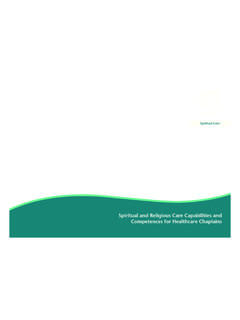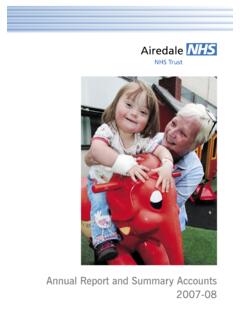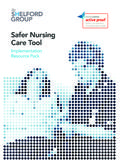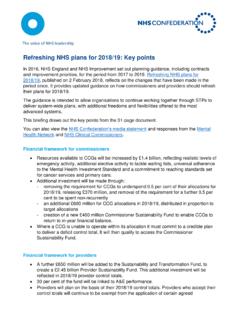Transcription of February 2011 - WHO
1 IHR CORE CAPACITY MONITORING framework :Checklist and Indicatorsfor Monitoring Progress in the Development of IHR Core Capacities in States PartiesInternational Health Regulations CoordinationWHO/HSE/ HEALTH REGULATIONS (2005) February 2011 IHR CORE CAPACITY MONITORING framework :Checklist and Indicatorsfor Monitoring Progress in the Development of IHR Core Capacities in States PartiesWHO/HSE/ HEALTH REGULATIONS (2005) February 2011 World Health Organization 2011 All rights designations employed and the presentation of the material in this publication do not imply the expression of any opinion whatsoever on the part of the World Health Organization concerning the legal status of any country, territory, city or area or of its authorities, or concerning the delimitation of its frontiers or boundaries. Dotted lines on maps represent approximate border lines for which there may not yet be full agreement. The mention of specific companies or of certain manufacturers products does not imply that they are endorsed or recommended by the World Health Organization in preference to others of a similar nature that are not mentioned.
2 Errors and omissions excepted, the names of proprietary products are distinguished by initial capital letters. All reasonable precautions have been taken by the World Health Organization to verify the information contained in this publication. However, the published material is being distributed without warranty of any kind, either express or implied. The responsibility for the interpretation and use of the material lies with the reader. In no event shall the World Health Organization be liable for damages arising from its of ContentsACKNOWLEDGEMENTS ..3 ACRONYMS ..4 GLOSSARY ..51. Introduction .. International Health Regulations (2005) Background .. Purpose and Scope.. The Process Used to Develop the Monitoring framework .. Intended Users ..132. Objectives of Monitoring the Development and Strengthening of IHR Core Capacities ..133. Conceptual framework for Monitoring IHR Core Capacity Strengthening ..144. Organization of the Monitoring Checklist.
3 155. Areas to be Monitored ..176. Definition of Capability Levels in the Monitoring framework ..197. Data Analysis and Interpretation of Findings .. Data Analysis .. Interpretation of Findings .. States Parties reports ..248. Outputs .. Information products .. Visualization of data ..249. Data Management at the national and global Levels ..2510. Data Management at the Global Level ..2611. Country Level Process for Collecting Data on Indicators ..26112. WHA Indicators ..2813. APPENDICES ..29 Appendix : Recommended checklist for monitoring progress of IHR core capacity development ..29 Appendix : Concepts applied in developing the checklist for monitoring IHR core capacities ..53 Appendix : Example of data collection form ..56 Appendix : Example of country overview of IHR core capacity development status ..57 Appendix : Example of IHR Core Capacity Monitoring Workshop outline ..58 Appendix : Example of gap analysis matrix ..61 Appendix : Comprehensive list of Indicators (28 indicators).
4 62 Appendix : Criteria for the selection of indicators to be reported to the WHA (mandatory) ..642 ACKNOWLEDGEMENTSThe production of this document was coordinated by Dr. Stella Chungong, Technical Coordinator of IHR National Capacity Monitoring Team, WHO, HEADQUARTERS SURVEILLANCE WORKING GROUP MEMBERSDr. Stella Chungong, Dr. Rajesh Sreedharan, Dr. Jun Xing, Dr. Bernardus Ganter, Dr. Max Hardiman, Mr. Bruce Plotkin, Ms. Riik ka Koskenmaki, Dr. Daniel Menucci, Ms. Anouk Berger, Dr. Sebastien Cognat, Mr. John Rainford, Ms. Asiya Odugleh-Kolev, Dr. Dominique Legros, Dr. Angela Merianos, Dr. May Chu, Dr. Veronique Thouvenot, Ms. Kathy O Neill, Dr. Jonathan Abrahams, Dr. Heather Papowitz, Dr. Kersten Gutschmidt, Dr. Zhanat Carr, Ms. Jennifer Bishop, Dr. Celine Gossner, Dr. Bernadette Abela, Dr. Andrea Ellis, Mr. Dominique Metais, Dr. Gu na l REGIONAL OFFICESWHO Regional Office for Africa: Dr. Florimond Tshioko, Dr. Adamou Yada, Dr.
5 Wondimagegnehu Alemu, Dr. Louis Ouedraogo, Dr. Fernando Da Silveira, Dr. Ali Yahaya, Dr. Peter Regional Office for the Americas: Dr. Marlo Libel, Dr. Carmen Regional Office for the Eastern Mediterranean Region: Dr. Hassan El Bushra, Dr. Martin Opoka, Dr. Manmur Malik, Dr. John Regional Office for Europe: Dr. Roberta Andragetti, Dr. Kivi Regional Office for South-East Asia: Dr. Suzanne Westman, Dr. Ayana Yeneabat, Dr. Augusto Regional Office for the Western Pacific: Dr. Kasai Takeshi, Dr. Ailan Li, Ms. Amy INSTITUTIONSThe U. S. Centers for Disease Control and Prevention, Atlanta: Dr. Mike St Louis, Dr. Ramesh Krishnamurthy, Dr. Scott McNabb, Dr. Tadesse Wuhib, Dr. Helen Perry, Dr. Robert Pinner, Dr. Ray Arthur, Dr. Goldie Centre for Epidemiology and Population Health, Australian National University, Australia: Dr. Mahomed of Public Health and Health Sciences, University of Massachusetts: Ms. Martha European Center for Disease Control and Prevention, Stockholm, Dr.
6 Denis National Institute of Infectious Diseases: Dr. Kiyosu deVeille Sanitaire, France: Dr. Mark African Field Epidemiology Network: Dr. Monica EXPERT GROUP MEETING MEMBERSN umerous consultations were held with technical experts who are all gratefully acknowledged, from WHO Member States (Brazil, Canada, the Democratic Republic of the Congo, France, Georgia, Japan, Kenya, Lebanon, the Philippines, Thailand, Uganda, Yemen and the United States of America), regional offices and partner STATESThe World Health Organization (WHO) is grateful to the following Member States for participating in the field-testing of this document: Bahrain, Cambodia, Canada, China, Egypt, Ghana, India, the Lao People s Democratic Republic, Nepal, Switzerland and WHO Regional Office for the AmericasICAO International Civil Aviation OrganizationIHR International Health Regulations (2005)INFOSAN International Food Safety Authorities NetworkIPC Infection prevention and controlMoH Ministry of HealthNFP National Focal PointNGO Non-governmental organizationPAHO Pan American Health OrganizationPoE Points of entryRRT Rapid response teamsSOP Standard operating procedureSWOT Strengths, weaknesses, opportunities and threats analysisUN United NationsWHA World Health AssemblyWHO World Health Organization45 GLOSSARYT erms and NB.
7 The following definitions have been provided for words and phrases found in the text and as they relate to their use in the context of this tool only, and may differ from those used in other , baggage, cargo, containers, conveyances, goods, postal parcels or human remains that are infected or contaminated, or carry sources of infection or contamination, so as to constitute a public health of a set of specific elements or characteristics that reflect the level of performance or achievement of a specific maintenance of safe conditions in biological research to prevent harm to workers, non-laboratory organisms and the levelindicates how far State Party has progressed towards attaining a given indicator, component and core definitiona case definition is a set of diagnostic criteria for use during surveillance and outbreak investigations that must be fulfilled for an individual to be regarded as a case of a particular disease for the purposes of surveillance and outbreak investigations.
8 Case definitions can be based on clinical criteria, laboratory criteria or a combination of the two along with the elements of time, place and person. The case definitions relating to the four diseases in connection with which all cases must be notified by States Parties to the World Health Organization (WHO), regardless of circumstances, are published on the WHO web site under the International Health Regulations (IHR) (2005) Annex 2. clusteran aggregation of relatively uncommon events or diseases in space and/or time in amounts that are believed or perceived to be greater than could be expected by chance (adapted from Last JM, ed. A Dictionary of Epidemiology, 2001).communicable disease or infectious diseasean illness due to a specific infectious agent or its toxic products that arises through transmission of that agent or its products from an infected person, animal or reservoir to a susceptible host, either directly or indirectly through an intermediate plant or animal host, vector or the inanimate environment (Last JM, ed.)
9 A Dictionary of Epidemiology, 2001).competent authorityan authority responsible for the implementation and application of health measures under the IHR (2005).componenta subset of the core capacity (see below). A set of indicators contribute to a component, and a group of components in turn measures the achievement of a core capacity which can be considered achieved when all of its components are in presence of an infectious or toxic agent or matter on a human or animal body surface, in or on a product prepared for consumption or on other inanimate objects, including conveyances, that may constitute a public health risk (IHR (2005)).core capacitythe essential public health capacity that States Parties are required to have in place throughout their territories pursuant to Articles 5 and 12, and Annex 1A of the IHR (2005) requirements by the year 2012. Eight core capacities are defined in this procedure whereby health measures are taken to eliminate an infectious or toxic agent or matter present on a human or animal body surface, in or on a product prepared for consumption or on other inanimate objects, including conveyances, that may constitute a public health procedure whereby health measures are taken to control or kill rodent vectors of human disease present in baggage, cargo, containers, conveyances, facilities, goods and postal parcels at the point of illness or medical condition, irrespective of origin or source, that presents or could present significant harm to ) a process that eliminates all pathogenic microorganisms, with the excep tion of bacterial spores, from inanimate objects, for the purpose of mi ni mi zing risk of infection (Infection prevention and control of epidemic- and pan demic-prone acute respiratory diseases in health care, WHO Interim Guidelines).
10 2) the procedure whereby health measures are taken to control or kill the insect vectors of human diseases present in baggage, cargo, containers, conveyances, goods and postal parcels (IHR (2005)).early warning systemin disease surveillance, a specific procedure to detect as early as possible any abnormal occurrence or any departure from usual or normally observed frequency of phenomena ( one case of Ebola fever). An early warning system is only useful if linked to mechanisms for early response. (Adapted from Last JM, A Dictionary of Epidemiology, 2001).evaluationa process that attempts to determine as systematically and objectively as possible the relevance, effectiveness and impact of activities in light of their objectives. This could include evaluation of structures, processes and outcomes (Adapted from Last JM, ed. A Dictionary of Epidemiology, 2000).eventa manifestation of disease or an occurrence that creates a potential for disease as result of events including, but not limited to those that are of infectious, zoonotic, food safety, chemical, radiological or nuclear origin or based surveillancethe organized and rapid capture of information about events that are a potential risk to public health including events related to the occurrence of disease in humans and events related to potential risk-exposures in humans.


















